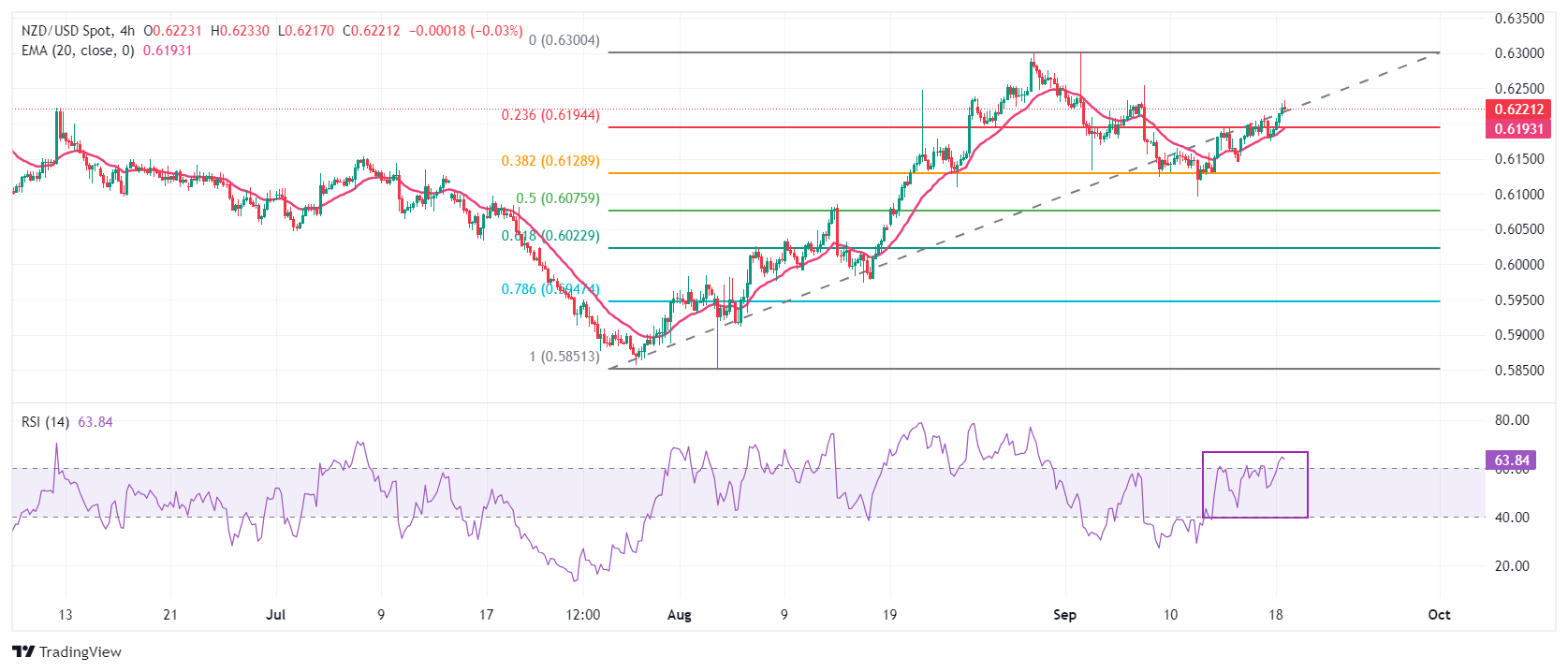NZD/USD Price Analysis: Rallies to 0.6230 with Fed policy taking centre stage
- NZD/USD surges to near 0.6230 as the Kiwi dollar performs strongly.
- Investors await the Fed’s interest rate decision, which is expected to be dovish.
- Traders lean towards Fed 50 bps rate cut prospects.
The NZD/USD pair delivers a sharp upside move to near 0.6230 in Wednesday’s North American session. The kiwi asset rallies as the New Zealand Dollar (NZD) strengthens despite the Reserve Bank of New Zealand (RBNZ) is expected to soften its Official Cash Rate (OCR) further due to weak economic performance and the US Dollar (USD) is down ahead of Federal Reserve’s (Fed) monetary policy decision.
For fresh insights on NZ’s economic health, investors will focus on the Q2 Gross Domestic Product (GDP) data, which will be published on Thursday. The NZ economy is estimated to have contracted by 0.5% on an annualized basis after growing by 0.3% in the second quarter of the last fiscal year.
Meanwhile, the major trigger for the Kiwi asset will be the Fed’s policy announcement at 18:00 GMT. The Fed is poised to deliver its first interest rate cut decision in more than four years. Investors will keenly focus on the Fed’s likely interest rate cut size and the dot plot.
According to the CME FedWatch tool, 30-day Federal Funds Futures pricing data shows that the probability of the central bank cutting rates by 50 basis points (bps) to 4.75%-5.00% is 61% and the rest favors a 25-bps rate cut.
NZD/USD extends its recovery above 23.6% Fibonacci retracement (plotted from the August 5 low of 0.5850 to the August 29 high of 0.6300) near 0.6200. Earlier, the asset rebounded strongly after retracing 38.2% from the August 29 high of 0.6300 to near 0.6130. The 20-period Exponential Moving Average (EMA) near 0.6200 continues to provide support to the New Zealand Dollar bulls.
The 14-period Relative Strength Index (RSI) stands above 60.00. A fresh round of bullish momentum could occur if the oscillator sustains around this level.
Further upside above the September 6 high of 0.6250 would drive the asset towards the September 2 high of 0.6300, followed by this year's high of 0.6330.
In an alternate scenario, a downside move would appear if the asset decisively breaks the July 17 high near 0.6100. This would push the asset lower to the May 3 high at 0.6046 and the psychological support of 0.6000.
NZD/USD four-hour chart

New Zealand Dollar FAQs
The New Zealand Dollar (NZD), also known as the Kiwi, is a well-known traded currency among investors. Its value is broadly determined by the health of the New Zealand economy and the country’s central bank policy. Still, there are some unique particularities that also can make NZD move. The performance of the Chinese economy tends to move the Kiwi because China is New Zealand’s biggest trading partner. Bad news for the Chinese economy likely means less New Zealand exports to the country, hitting the economy and thus its currency. Another factor moving NZD is dairy prices as the dairy industry is New Zealand’s main export. High dairy prices boost export income, contributing positively to the economy and thus to the NZD.
The Reserve Bank of New Zealand (RBNZ) aims to achieve and maintain an inflation rate between 1% and 3% over the medium term, with a focus to keep it near the 2% mid-point. To this end, the bank sets an appropriate level of interest rates. When inflation is too high, the RBNZ will increase interest rates to cool the economy, but the move will also make bond yields higher, increasing investors’ appeal to invest in the country and thus boosting NZD. On the contrary, lower interest rates tend to weaken NZD. The so-called rate differential, or how rates in New Zealand are or are expected to be compared to the ones set by the US Federal Reserve, can also play a key role in moving the NZD/USD pair.
Macroeconomic data releases in New Zealand are key to assess the state of the economy and can impact the New Zealand Dollar’s (NZD) valuation. A strong economy, based on high economic growth, low unemployment and high confidence is good for NZD. High economic growth attracts foreign investment and may encourage the Reserve Bank of New Zealand to increase interest rates, if this economic strength comes together with elevated inflation. Conversely, if economic data is weak, NZD is likely to depreciate.
The New Zealand Dollar (NZD) tends to strengthen during risk-on periods, or when investors perceive that broader market risks are low and are optimistic about growth. This tends to lead to a more favorable outlook for commodities and so-called ‘commodity currencies’ such as the Kiwi. Conversely, NZD tends to weaken at times of market turbulence or economic uncertainty as investors tend to sell higher-risk assets and flee to the more-stable safe havens.


